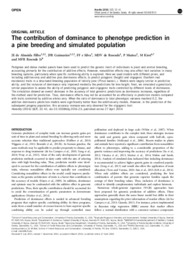The contribution of dominance to phenotype prediction in a pine breeding and simulated population.
The contribution of dominance to phenotype prediction in a pine breeding and simulated population.
Author(s): ALMEIDA FILHO, J. E. de; GUIMARÃES, J. F. R.; SILVA, F. F. e; RESENDE, M. D. V. de; MUÑOZ, P.; KIRST, M.; RESENDE JUNIOR, M. F. R.
Summary: Pedigrees and dense marker panels have been used to predict the genetic merit of individuals in plant and animal breeding, accounting primarily for the contribution of additive effects. However, nonadditive effects may also affect trait variation in many breeding systems, particularly when specific combining ability is explored. Here we used models with different priors, and including additive-only and additive plus dominance effects, to predict polygenic (height) and oligogenic (fusiform rust resistance) traits in a structured breeding population of loblolly pine (Pinus taeda L.). Models were largely similar in predictive ability, and the inclusion of dominance only improved modestly the predictions for tree height. Next, we simulated a genetically similar population to assess the ability of predicting polygenic and oligogenic traits controlled by different levels of dominance. The simulation showed an overall decrease in the accuracy of total genomic predictions as dominance increases, regardless of the method used for prediction. Thus, dominance effects may not be accounted for as effectively in prediction models compared with traits controlled by additive alleles only. When the ratio of dominance to total phenotypic variance reached 0.2, the additive?dominance prediction models were significantly better than the additive-only models. However, in the prediction of the subsequent progeny population, this accuracy increase was only observed for the oligogenic trait.
Publication year: 2016
Types of publication: Journal article
Unit: Embrapa Forestry
Keywords: Árvore conífera
Observation
Some of Embrapa's publications are published as ePub files. To read them, use or download one of the following free software options to your computer or mobile device. Android: Google Play Books; IOS: iBooks; Windows and Linux: Calibre.
Access other publications
Access the Agricultural Research Database (BDPA) to consult Embrapa's full library collection and records.
Visit Embrapa Bookstore to purchase books and other publications sold by Embrapa.

